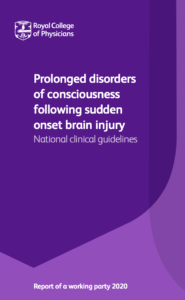
Module 2: Palliative Care
2.3 Clinical management
A crucial document for anyone providing care to PDoC patient is the ‘National Clinical Guidelines on Prolonged Disorders of Consciousness’ published by the Royal College of Physicians in 2020. These guidelines include detailed clinical advice about supportive palliative care for PDoC patients (see Section 5b where you will find 13 pages addressing “Practical management of end-of-life care for patients with PDoC” pp151-164).
The guidelines underline the need for a team-based approach with close coordination between specialists in palliative care and neuro-disability management and emphasise the importance of careful planning ahead and briefing staff in advance.
Professor Lynne Turner-Stokes, who chaired the RCP Working Party, emphasises positive, active management.

The experts on the RCP Working Party highlight that PDoC patients may have specific clinical needs including, for example, issues around handling and postural management because of complex spasticity or involuntary movements. There are detailed recommendations for how existing medications, and additional sedation or pain relief, are administered.
The guidelines emphasise that while the dying process for these patients can be straightforward, in some cases it may be unpredictable. Close monitoring of the patient is recommended. The guidelines also emphasise that where end-of-life care is provided outside a specialist setting there should be arrangements in place for immediate escalation of care when necessary.
If you are responsible for developing patients’ care plans then have a look at the guidelines in the National PDoC guidance from the RCP at: https://www.rcp.ac.uk/media/ptcoggi5/pdoc-guidelines_final_online_0_0.pdf
In particular, look at the following tables: 5.2a Principles and pre-requisites of the palliative care regimen and 5.2b Staged escalation of palliative care regimen using SC administration
- The guidelines mention some of the possible symptoms linked to certain types of severe brain injury eg “dysautonomia leading to ‘un-damped’ homeostatic responses”. Are you already familiar with these?
- What about some of the recommendations for medication escalation plans?
Optional Continuing Professional Development (Unit 2.3). Clinical management
If you want to deepen your knowledge in this area then click on the box bellow to see the optional CPD exercise below which will support you to engage in detail with key clinical aspects of the RCP guidance on palliative care for PDoC patients.
Otherwise, just skip over the optional exercise and move on through the rest of the course.
CLICK HERE for optional CPD exercise: Clinical management and care plan
Read section 5b (pp 151-164) of the ‘National Clinical Guidelines on Prolonged Disorders of Consciousness’ published by the Royal College of Physicians in 2020. This section gives detailed clinical advice about supportive palliative care for PDoC patients
- Note down responses to the following questions: Is there anything different from your normal practice? What bits of the guidance do you find particularly useful? What issues need particular attention when drawing up a care plan for a PDoC patient in this situation?
- Draft an end-of-life care plan, highlighting where you would need to collect additional information to make the plan relevant to a particular individual.
UNIT QUIZ
Check your understanding by answering the 3 questions below
The focus of palliative care is on the patient, and providing the right care for them. However, support for families, and for staff, is important too.
- The next module discusses staff experiences of being involved in caring for patients around the withdrawal of CANH. It includes film clips from interviewees and invites you to reflect on how you or colleagues might feel. It concludes with suggestions for support strategies.
- The module after that focuses on families and includes film clips from people talking about the death of their relative. The unit concludes with suggestions for how to support families.
Don’t forget to press the ‘Mark as Complete’ button at the bottom of the page before moving on.

